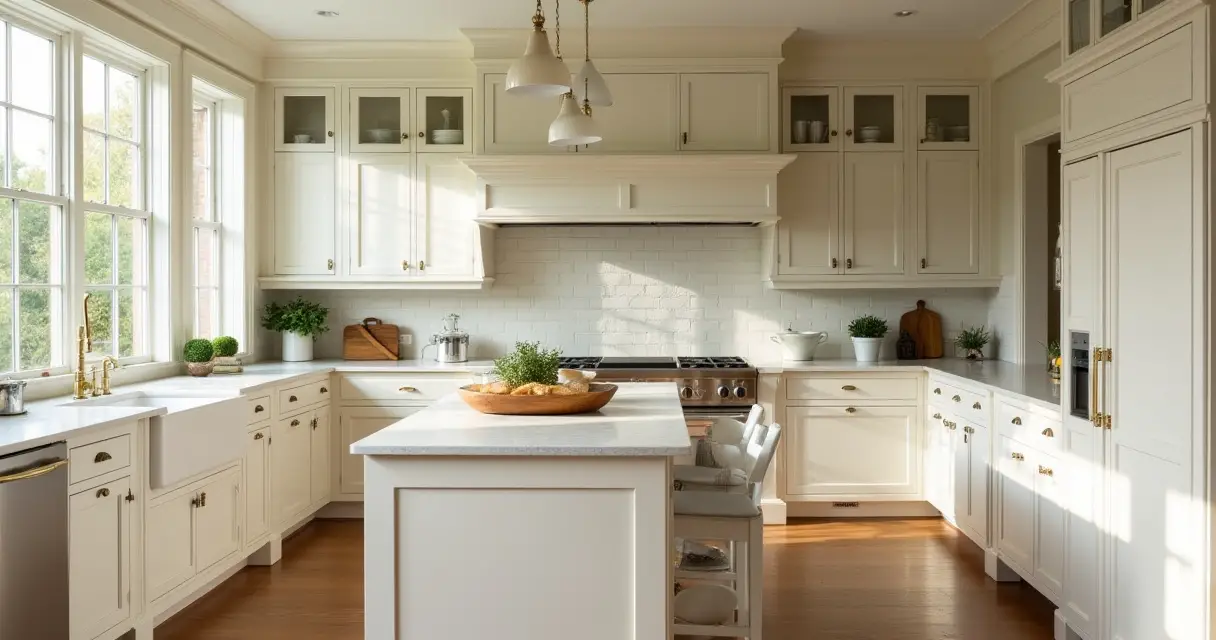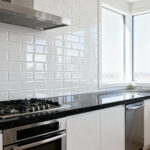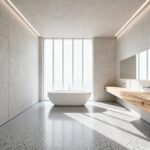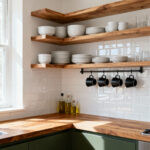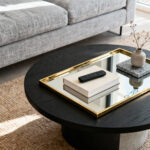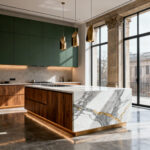Can we talk for a minute about why so many “traditional” kitchens on Pinterest look completely lifeless? You know the ones. All white, a generic farmhouse sink, and maybe some brass hardware that will look dated in three years. That’s not traditional design. That’s a theme park version of it. I used to think creating a truly traditional space was about following a checklist of historic features. Then I spent 15 years photographing homes for architectural magazines, and I learned the real secret.
What actually matters is a deep understanding of proportion, material honesty, and craftsmanship. It’s not about recreating a museum; it’s about applying principles that have worked for centuries to create a room that feels both grounded and deeply comfortable. The noise is all the fleeting trends—the weird tile shape of the year, the “it” color that everyone’s using. The real story is in the bones of the room. I once watched a client sink a fortune into a kitchen that ticked all the “traditional” boxes, but they used cheap, hollow-core doors and flimsy hardware. From 20 feet away, my camera could see it looked okay. But up close? It felt like a movie set. All surface, no soul.
So, let me give you the real story. Here are the shortcuts and principles I wish I’d known when I started, broken down into what actually works and why.
Establishing Your Traditional Kitchen Foundation (Part 1)
Before you even think about a backsplash or a faucet, you have to get the foundation right. This isn’t just about the floor plan; it’s about the architectural shell of the room. These initial decisions about layout, color, and built-in elements are what will make or break the entire project. Get this part right, and the rest is easy. Get it wrong, and you’ll spend years trying to fix a room that just never feels quite right.
1. Prioritize Functional Layouts Over Trendy Ones
A kitchen that’s a pain to work in will never feel right, no matter how beautiful it is. Forget the sprawling, open-plan layouts you see in magazines if your family actually cooks. The classic work triangle—the path between the sink, stove, and refrigerator—is a classic for a reason: it works. The goal is efficiency and flow, making the path from fridge to prep space to cooktop feel intuitive and effortless.
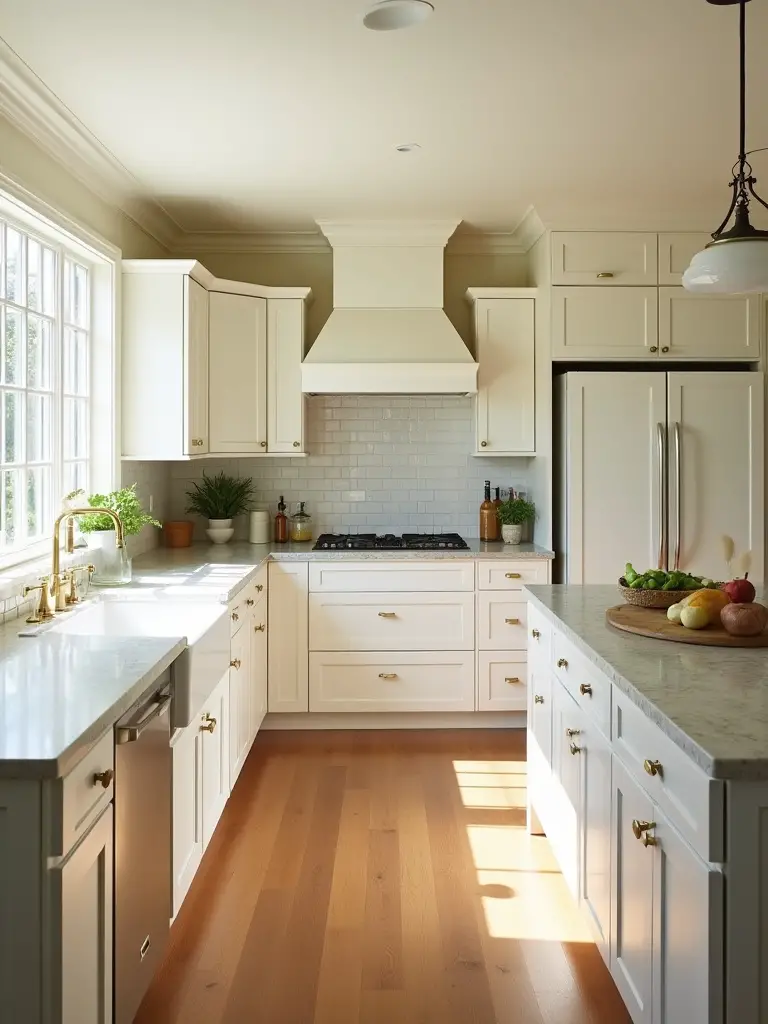
I once shot a kitchen with a massive, 20-foot island. It looked impressive, but the homeowner confessed it was a nightmare. She had to run laps around it just to make dinner. A truly traditional layout is about human scale and purpose. It’s a space that anticipates your next move, not one that forces you into an awkward dance. Before you sign off on a plan, walk through the motions of making coffee, unloading groceries, and cooking a complex meal. If it feels cumbersome on paper, it will be ten times worse in reality.
2. Embrace Timeless Color Palettes for Lasting Appeal
As a photographer, I can tell you that light and color are everything. A traditional kitchen relies on a palette that feels natural and established. Think warm whites, creamy ivories, soft grays, deep blues, and muted greens. These colors have an inherent depth that plays beautifully with natural light throughout the day, shifting and changing in a way that stark, primary colors just can’t. They form a quiet, sophisticated backdrop that lets the quality of your materials shine.
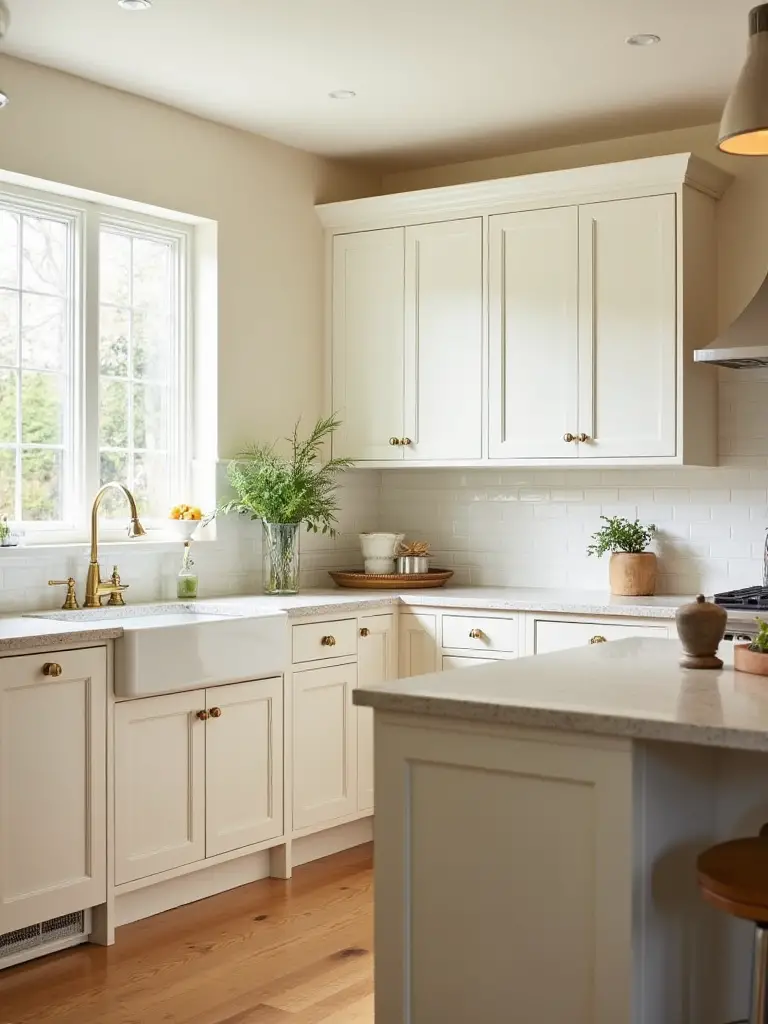
The biggest mistake I see is people choosing a “white” paint without understanding its undertones. A cool, blue-toned white can make a kitchen with warm wood floors look sterile and disconnected. A creamy white with a yellow undertone, however, will harmonize with it beautifully. Always, always test large swatches of your paint choices on different walls and look at them at different times of day. What looks perfect in the morning sun might look sickly under artificial light at night.
3. Invest in Classic Cabinetry Styles Like Shaker or Raised Panel
Your cabinets are the primary architectural element in the kitchen. Their style defines the space. You can’t go wrong with Shaker or raised panel doors. They are the blue jeans and white t-shirt of the kitchen world—they never go out of style. The simple, clean lines of a Shaker door create subtle shadow lines that add depth without fussiness. A raised panel door offers a more formal, detailed look with beautiful beveling that catches the light.
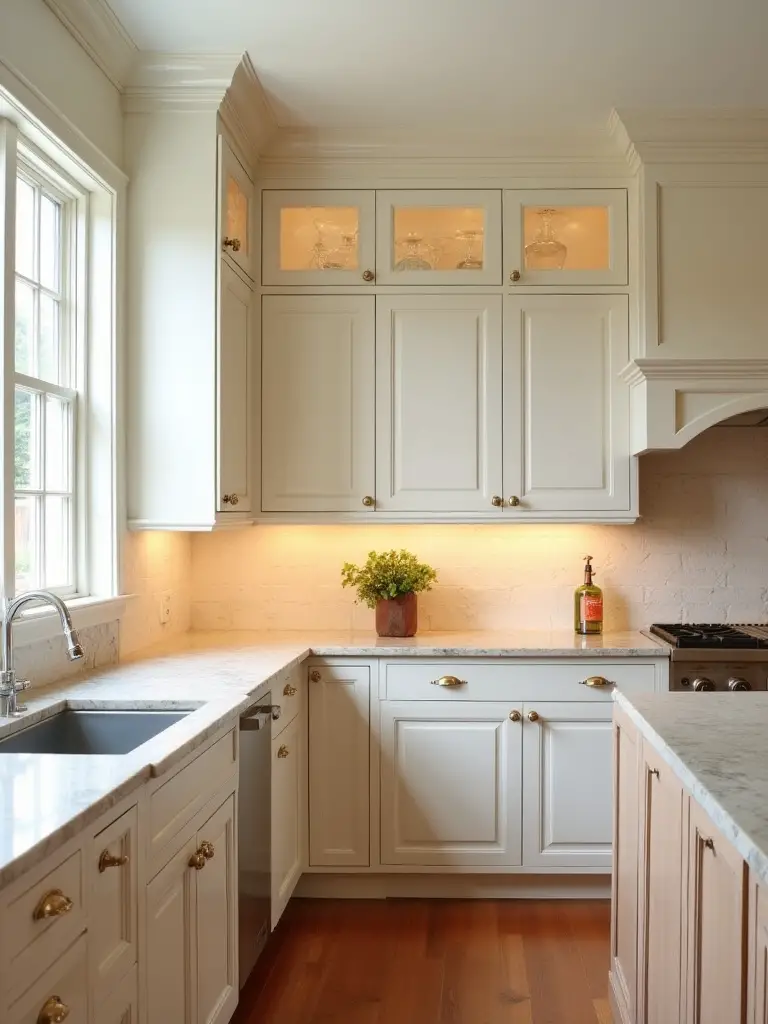
But the style is only half the story. The material and construction are what really matter. Insist on solid wood frames and high-quality construction like dovetail joints in your drawers. When you open a well-made cabinet, you feel its substance. It doesn’t rack or feel flimsy. This is a long-term investment. I can tell you from experience, cheap cabinets might look okay for the first year, but they won’t stand up to the daily abuse of a real kitchen.
4. Integrate Crown Molding and Decorative Trim for Architectural Depth
A kitchen without molding is like a picture without a frame. It just feels unfinished. Crown molding is the critical piece that connects your cabinets to the ceiling, creating a custom, built-in look that eliminates that awkward, dust-collecting gap. But don’t stop there. Light rail molding under your upper cabinets hides under-cabinet lighting and gives them a finished edge. Baseboard and shoe molding ground the lower cabinets to the floor.
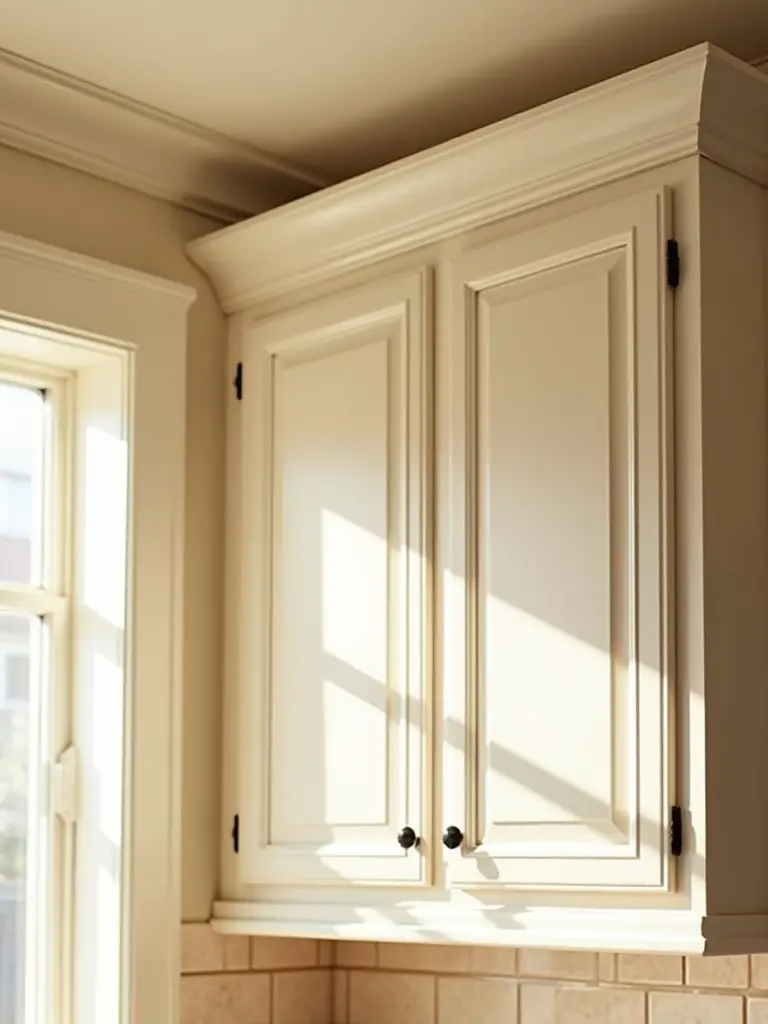
This isn’t about adding fussy, ornate details everywhere. It’s about creating clean, architectural transitions. When I’m setting up a shot, my eye is always drawn to these details. They create layers and shadows that give a room dimension and a sense of permanence. This is what separates a high-end, thoughtful design from a standard, builder-grade installation. It’s a relatively small cost that makes a massive visual impact.
Establishing Your Traditional Kitchen Foundation (Part 2)
Now that we’ve framed the room with the right layout and architectural details, let’s get down to the surfaces you’ll walk on and the visual logic that holds it all together. The floor you choose and the way you arrange your cabinets are just as foundational as the walls themselves.
5. Consider Traditional Flooring Materials for Authentic Charm
The floor is the fifth wall of your kitchen, and it sets the tactile and auditory tone for the entire space. Traditional kitchens feel grounded, and nothing does that better than classic materials like natural wood or stone. Wide-plank hardwood floors, whether oak, hickory, or walnut, add immense warmth and develop a beautiful patina over time. Every scratch and scuff tells a part of your family’s story. They also feel wonderful underfoot and help absorb sound.
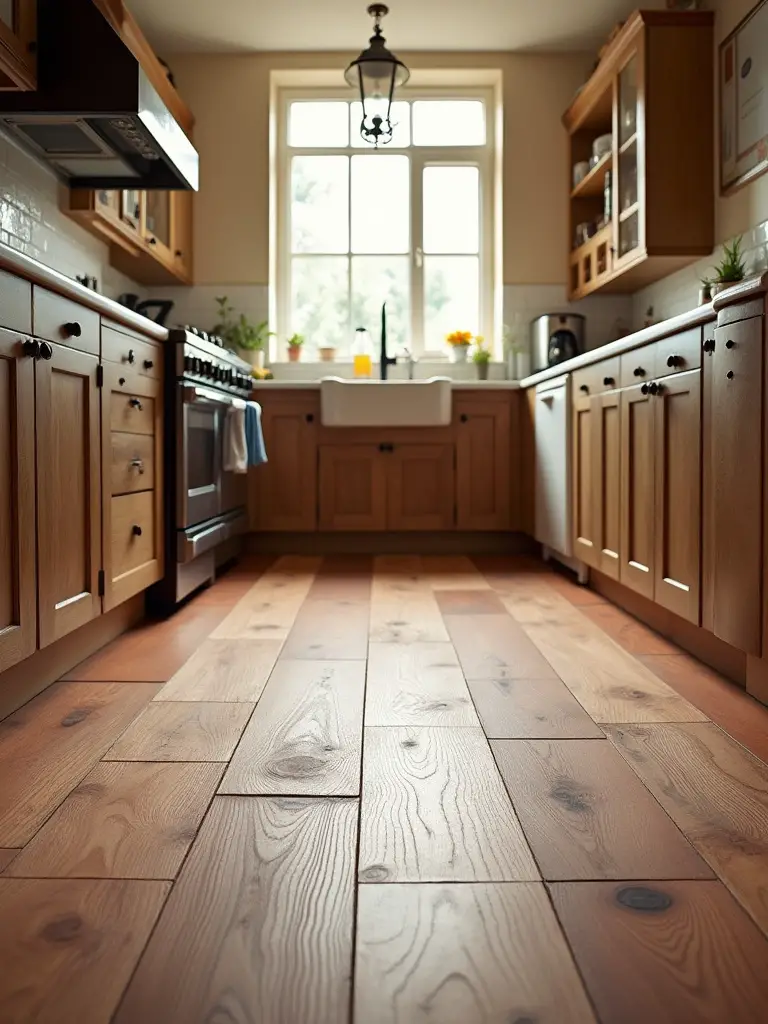
Natural stone like slate, limestone, or marble is another timeless option, offering incredible durability and a connection to the earth. A classic black-and-white checkerboard pattern in ceramic or marble tile is another no-fail choice that brings a touch of historical whimsy. What you want to avoid are materials that try to imitate something else, like wood-look tile or cheap laminate. They lack the honesty and integrity that are hallmarks of traditional design. An authentic material will always age more gracefully than a fake one.
6. Design for Symmetry and Balance in Cabinetry and Features
From a compositional standpoint—and trust me, this is what a photographer obsesses over—symmetry is your best friend in a traditional kitchen. Our brains are hard-wired to find balance and order pleasing. This doesn’t mean every single element has to be a perfect mirror image, but there should be a sense of visual equilibrium. A classic approach is to create a strong focal point, like a statement range and hood, and then flank it with identical upper cabinets or windows.
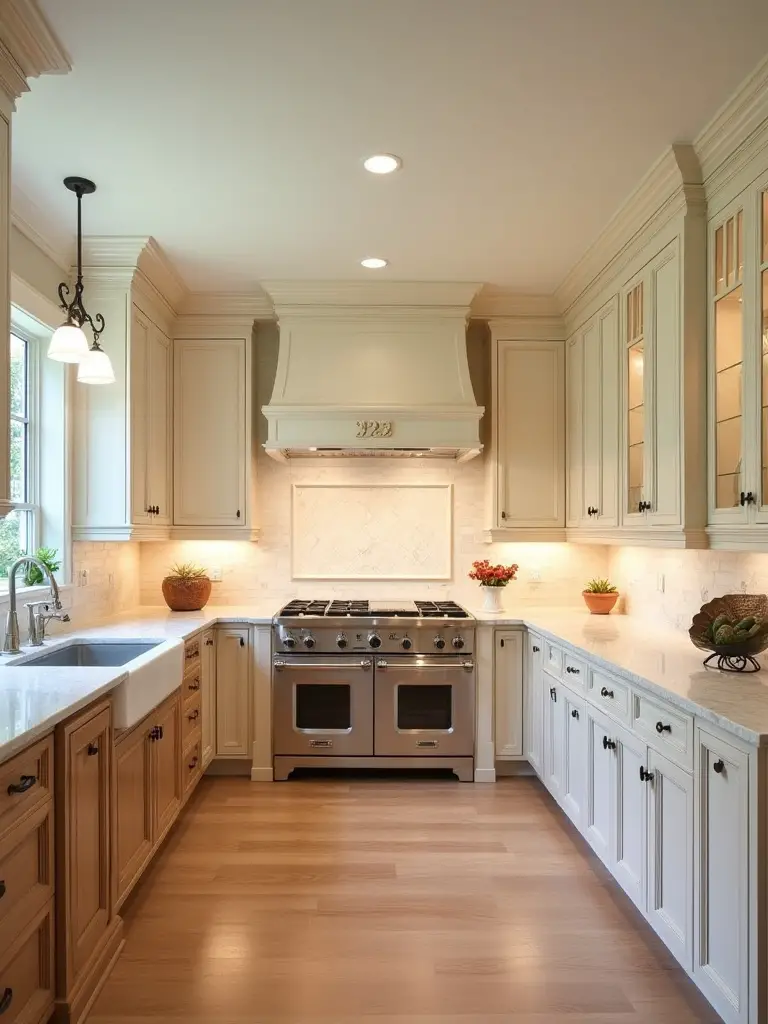
If you can’t achieve perfect symmetry, aim for balance. A large, panel-ready refrigerator on one side of the room can be visually balanced by a tall pantry cabinet of the same height and mass on the other. This creates an invisible line of sight that feels intentional and calm. A cluttered, asymmetrical layout, by contrast, forces the eye to jump all over the place, creating a subtle sense of chaos that undermines the serene feeling you’re trying to create.
Selecting Key Fixtures and Surfaces for Classic Charm (Part 1)
With the room’s structure firmly in place, it’s time to focus on the elements you interact with every single day. The countertops, the sink, the backsplash—these are the workhorses of the kitchen. Choosing them wisely is about balancing timeless beauty with real-world durability.
7. Choose Durable and Elegant Countertop Materials with Subtle Character
Your countertop is a massive visual plane, so its material has to be right. Forget anything too busy or trendy. For a traditional kitchen, you want materials with subtle, organic character. Natural stones like marble, quartzite, or soapstone are perennial favorites. Yes, marble can etch and stain, but many people feel that the patina it develops over time—the so-called “evidence of a life well-lived”—only adds to its charm. For a more durable option, look at quartzite, which often has the soft look of marble without the maintenance headaches.
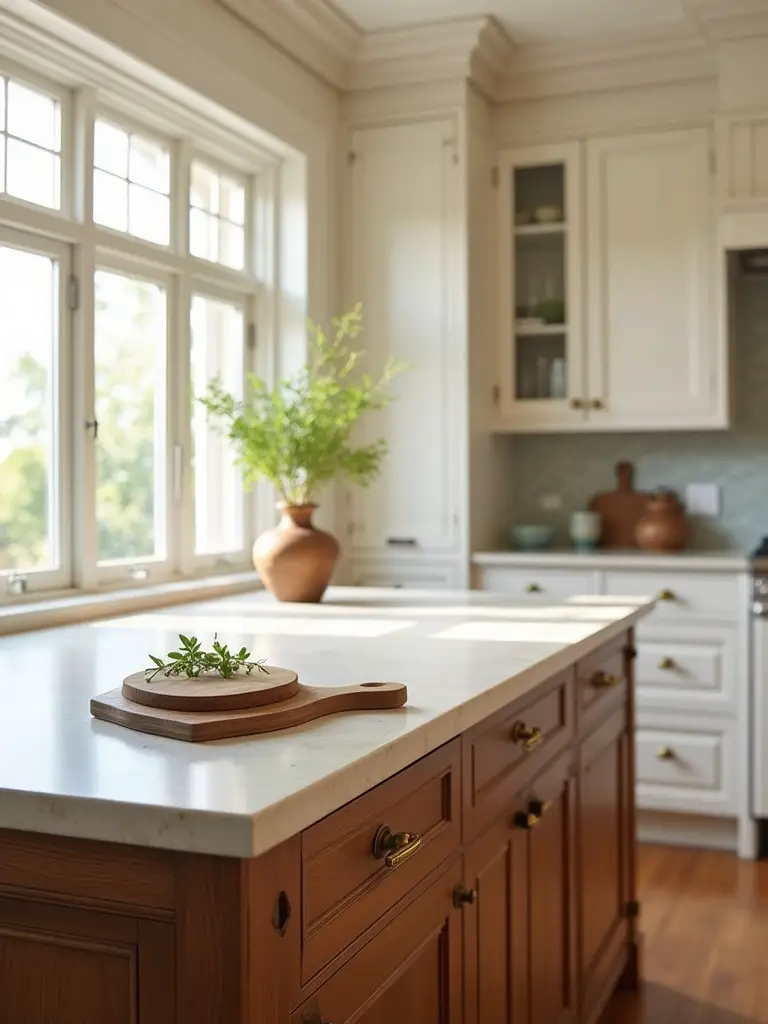
Honed or leathered finishes are often a better fit for traditional spaces than a high-gloss polish. A honed finish has a soft, matte look that absorbs light rather than reflecting it, which helps create a warmer, less glitzy feel. If you opt for engineered quartz, choose a pattern that mimics natural stone subtly. Avoid the ones with loud, repetitive patterns or glittery flecks, as they will instantly scream “2020s” a decade from now.
8. Incorporate Classic Backsplash Patterns like Subway Tile or Beadboard
The backsplash is an opportunity to add texture without overwhelming the space. You simply cannot go wrong with a classic ceramic subway tile. It’s been a staple for over a hundred years for a reason. But the secret is in the details. A handmade tile will have slight imperfections and undulations on its surface that catch the light beautifully, adding a layer of subtle texture that a perfectly flat, machine-made tile lacks. And pay attention to your grout color! A matching grout creates a quiet, seamless look, while a contrasting grout creates a bold, graphic pattern that can feel more industrial or modern.
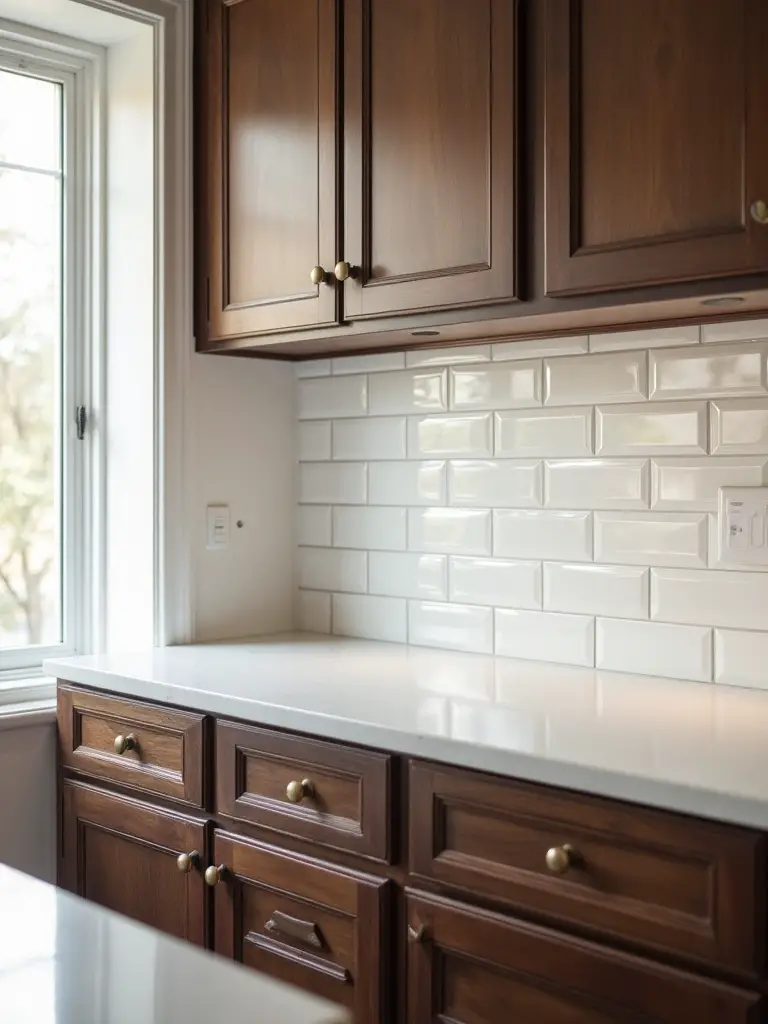
Another fantastic option is beadboard. Installed as a backsplash, it adds vertical lines and a cozy, slightly Rustic charm that’s perfect for farmhouse or cottage-style traditional kitchens. Painted in a durable, wipeable semi-gloss finish, it’s just as practical as tile but offers a much softer look. It’s a simple detail that delivers a huge amount of character.
9. Select Traditional Style Sinks and Faucets for Period Authenticity
The sink and faucet are the most-used fixtures in your kitchen. They are tactile elements that need to feel as good as they look. An apron-front or “farmhouse” sink, whether made of durable fireclay or classic cast iron, serves as a beautiful, hefty anchor for the clean-up zone. They have a substance and presence that an ordinary stainless steel undermount sink just can’t match.
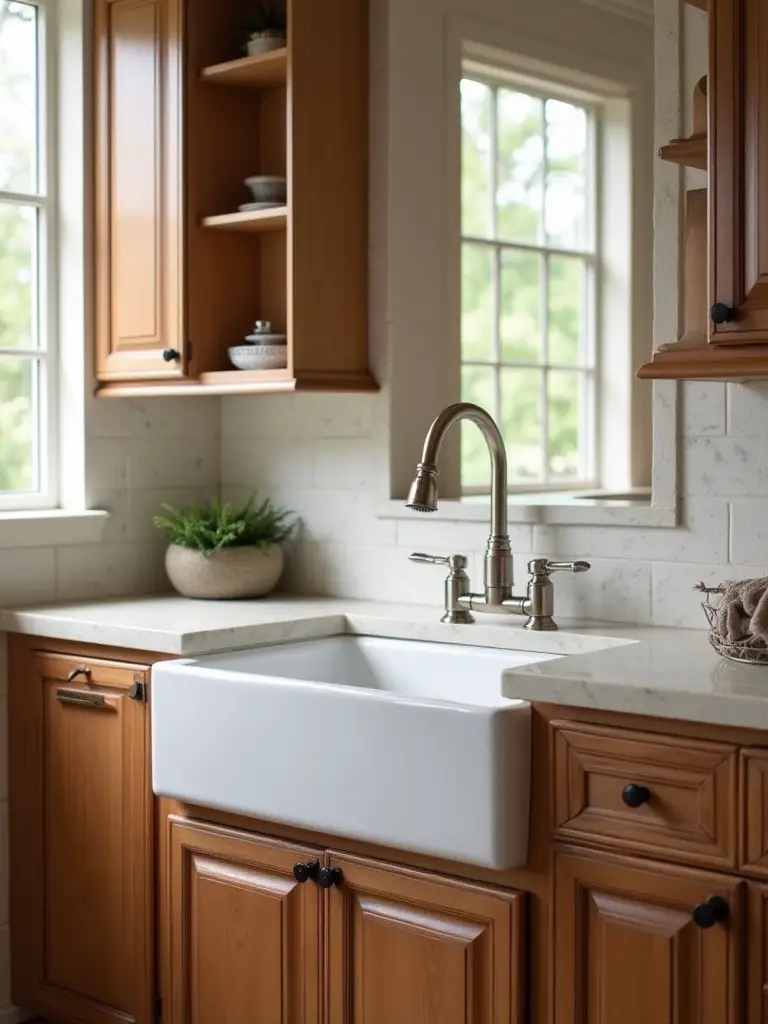
For the faucet, look for classic shapes like a bridge faucet or a gooseneck with traditional lever or cross handles. And focus on the finish. Polished nickel has a warm, silvery hue that is softer than chrome. Unlacquered brass will develop a gorgeous, rich patina over time. Oil-rubbed bronze provides a dark, handsome contrast. The key is to choose fixtures that feel solid and well-engineered. This is not the place to save a few hundred dollars.
10. Conceal Modern Appliances Strategically with Custom Panels
Nothing shatters the illusion of a timeless, traditional kitchen faster than a massive slab of stainless steel. If your budget allows, opting for “panel-ready” appliances is a game-changer. These appliances are designed to be fitted with custom cabinet panels that match the rest of your kitchen, allowing your refrigerator and dishwasher to completely disappear into the surrounding cabinetry.
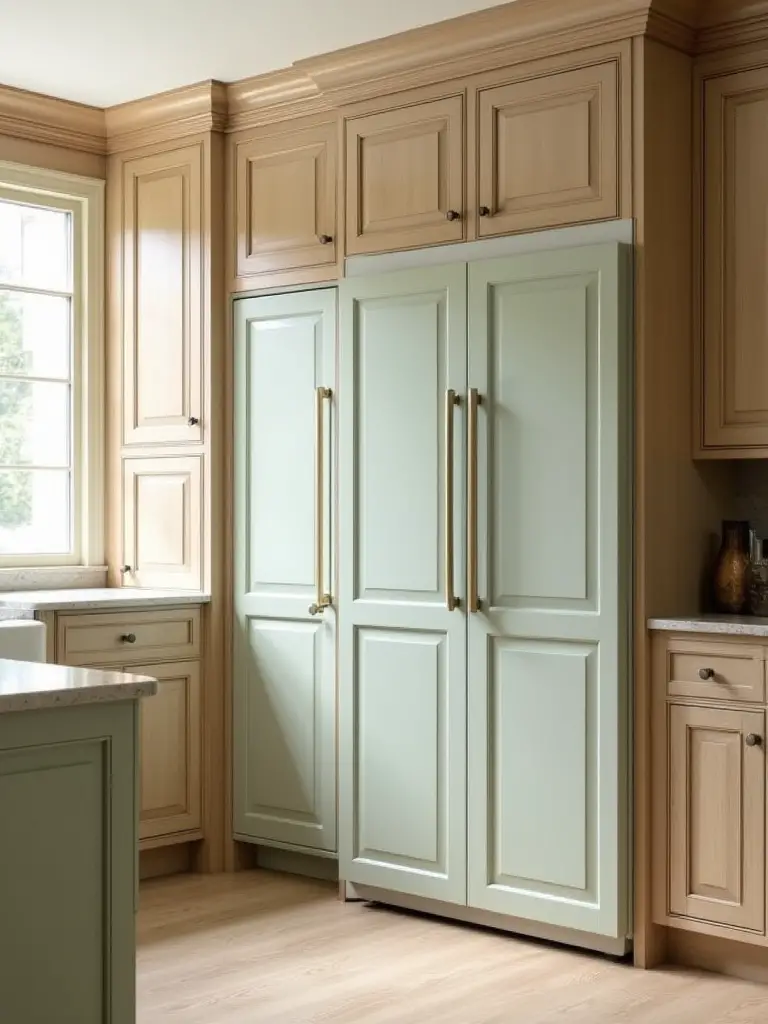
This creates a seamless, uninterrupted wall of beautiful millwork that is incredibly sophisticated. When you conceal the appliances, you’re no longer designing a room around a collection of machines. Instead, you’re creating an elegant, cohesive space that just happens to contain a high-functioning kitchen. It elevates the entire design from a utility room to a truly beautiful living space.
Selecting Key Fixtures and Surfaces for Classic Charm (Part 2)
We’ve covered the main surfaces and work stations. Now, let’s look up. The features that command attention from eye-level—the range hood and the light fixtures—are your opportunity to make a powerful statement and define the room’s entire mood.
11. Feature a Statement Range Hood as a Traditional Focal Point
If the kitchen is the heart of the home, the range hood is the hearth. It’s the natural focal point and deserves to be treated as an architectural feature, not just a metal box. A custom-built hood can be designed to perfectly match your cabinetry for a cohesive look, or it can be crafted from a contrasting material to make a bold statement. Imagine a simple, elegant hood made of curved plaster, a rustic one made from reclaimed wood, or a dramatic one clad in hammered copper or zinc.
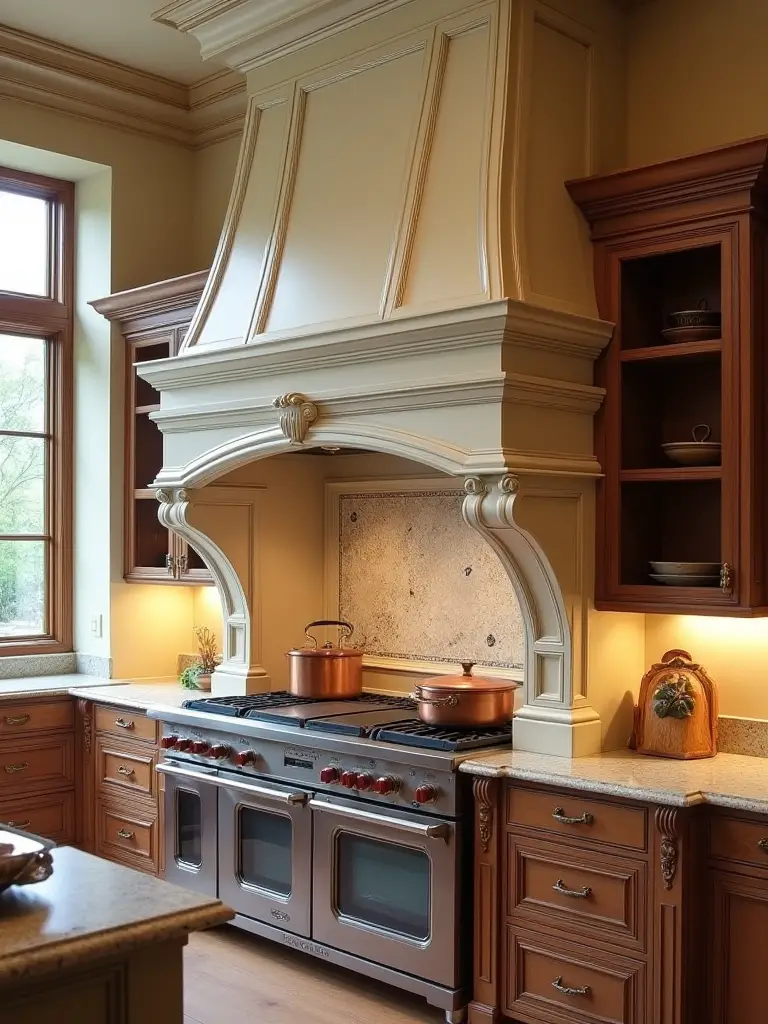
From a photographic perspective, the range hood anchors the entire composition of the main kitchen wall. It provides a center point around which everything else can be balanced. Its scale is critical—it should be slightly wider than your cooktop to feel properly proportioned and to effectively capture steam and smoke. This is your chance to add a powerful, sculptural element to the room. Don’t waste it on a boring, off-the-shelf unit.
12. Integrate Period-Appropriate Lighting Fixtures for Ambiance and Task
Lighting is one of the most-botched elements in kitchen design. You need layers of light. One sad ceiling fixture in the middle of the room isn’t going to cut it. A good lighting plan has three distinct layers that work together to create a space that is both functional and inviting.
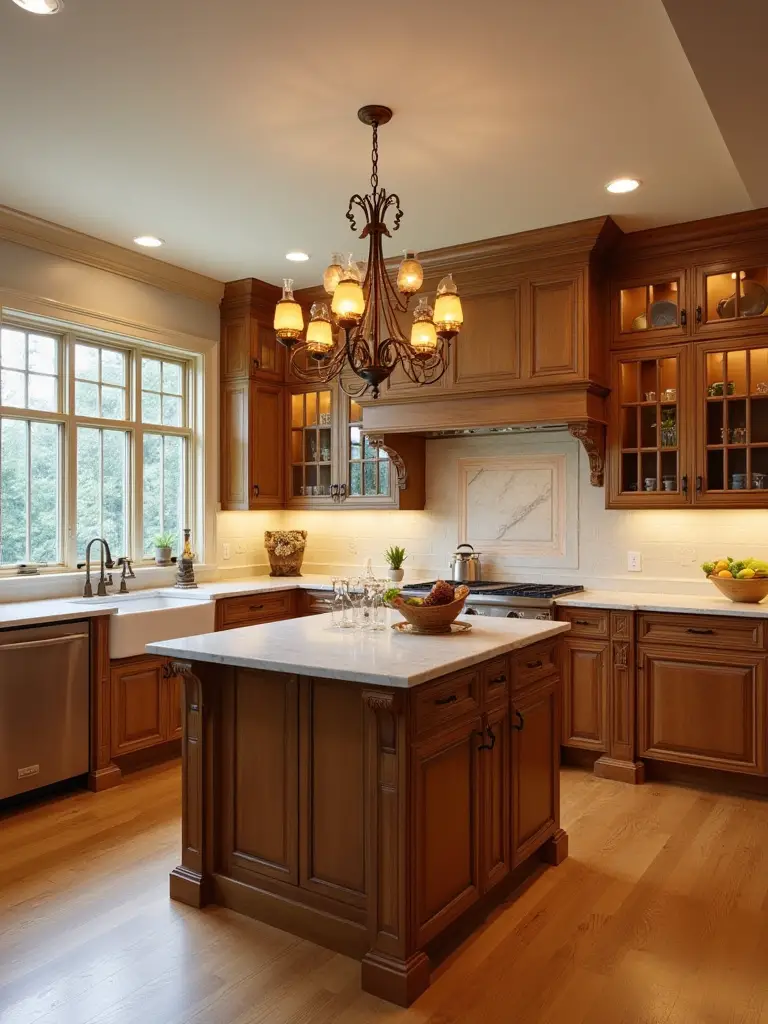
- Ambient Light: This is the overall illumination. A beautiful chandelier, a set of flush mounts, or several large pendants can provide a soft, general glow.
- Task Light: This is the focused light you need for working. Under-cabinet lighting is non-negotiable. It illuminates your countertops without casting shadows. Pendants over an island or a sconce over the sink are also key task lights.
- Accent Light: This is the “jewelry” lighting. Think about small picture lights over artwork or in-cabinet lighting to highlight a collection of glassware behind glass doors.
And always, always put everything on a dimmer. This gives you complete control over the mood, allowing you to transition from bright, full-task lighting for cooking to a soft, warm glow for a quiet dinner.
Adding Decorative Details and Functional Enhancements (Part 1)
The major components are now in place. The final step is to layer in the details that give a traditional kitchen its soul. These are the elements that make a space feel personal, collected over time, and uniquely yours.
13. Choose Hardware with Historical Authenticity for Cabinetry
Cabinet hardware is the jewelry of the kitchen. It’s a small detail that makes an enormous difference. The weight, feel, and finish of your knobs and pulls are tactile details you’ll interact with every day. For a traditional look, steer clear of sleek, modern bar pulls. Instead, look for classic bin or cup pulls for drawers and simple knobs for doors.
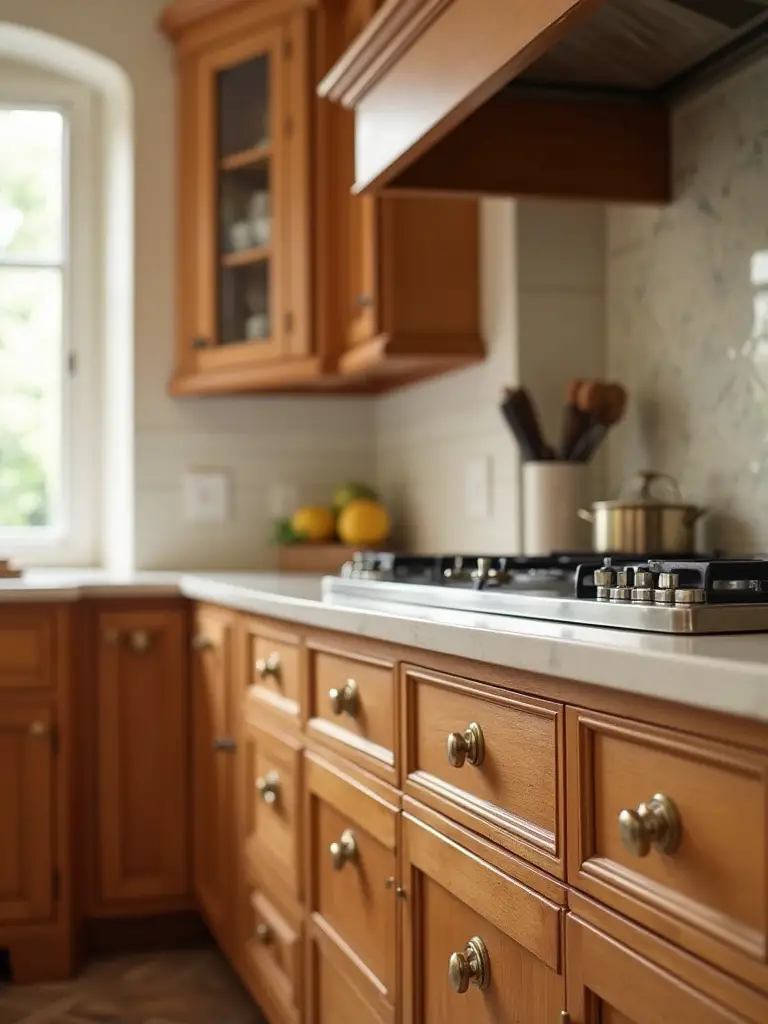
Materials like aged brass, polished nickel, oil-rubbed bronze, and even porcelain are all excellent choices. For the ultimate authentic touch, choose unlacquered brass. It will arrive shiny, but over months and years, it will develop a deep, rich patina that is impossible to fake. This living finish adds a layer of history and character that is the very essence of traditional design. It’s a testament to quality that gets better with age.
14. Incorporate Open Shelving with Decorative Brackets for Display
You don’t want an entire kitchen of open shelves—that’s a maintenance nightmare. But incorporating a small section can break up a long wall of solid upper cabinets and provide a beautiful space to display your most-used dishes, favorite cookbooks, or a few pieces of art. It makes a kitchen feel less like a laboratory and more like a living space.
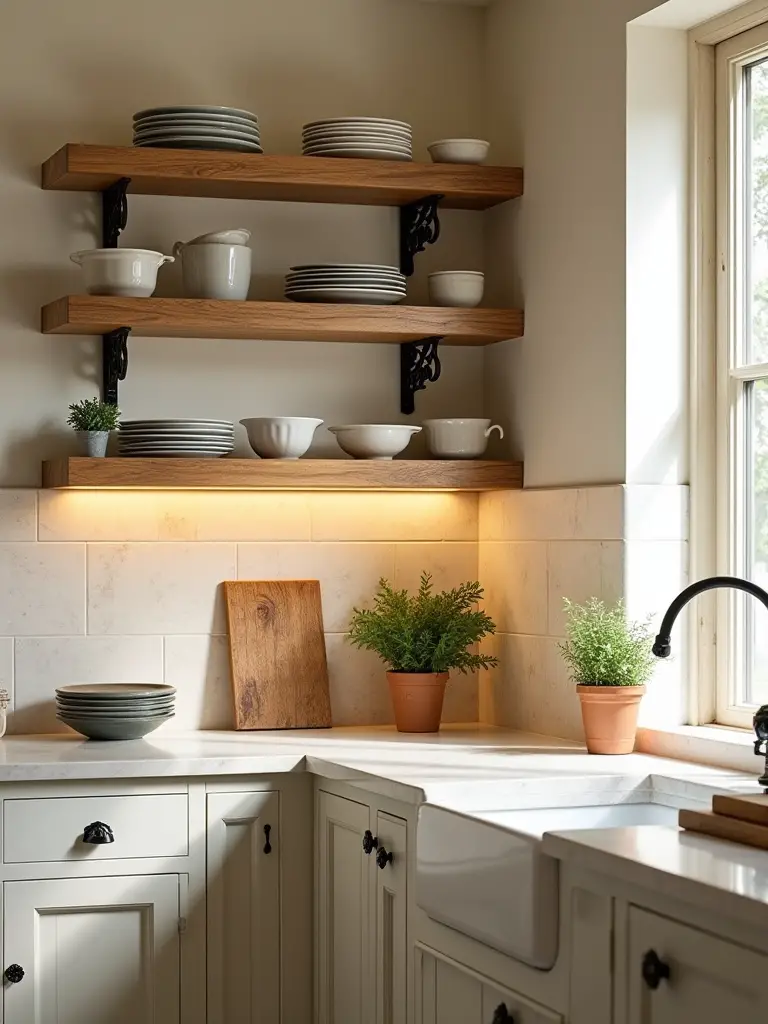
The secret to making open shelving feel traditional is in the details. Use thick, solid wood shelves that feel substantial, not thin, flimsy ones. And most importantly, support them with beautiful, decorative brackets. Whether they are hand-carved wood corbels or ornate cast iron brackets, these supports add a crucial architectural element that makes the shelving feel intentional and integrated, rather than like a cheap afterthought.
15. Integrate Glass-Front Cabinet Doors to Add Visual Lightness
Similar to open shelving, a few strategically placed glass-front doors can provide a welcome visual break. They allow the eye to travel deeper into the cabinet, which makes the entire kitchen feel larger and more open. They’re perfect for an upper cabinet where you store your everyday glasses or a pretty set of dishes.
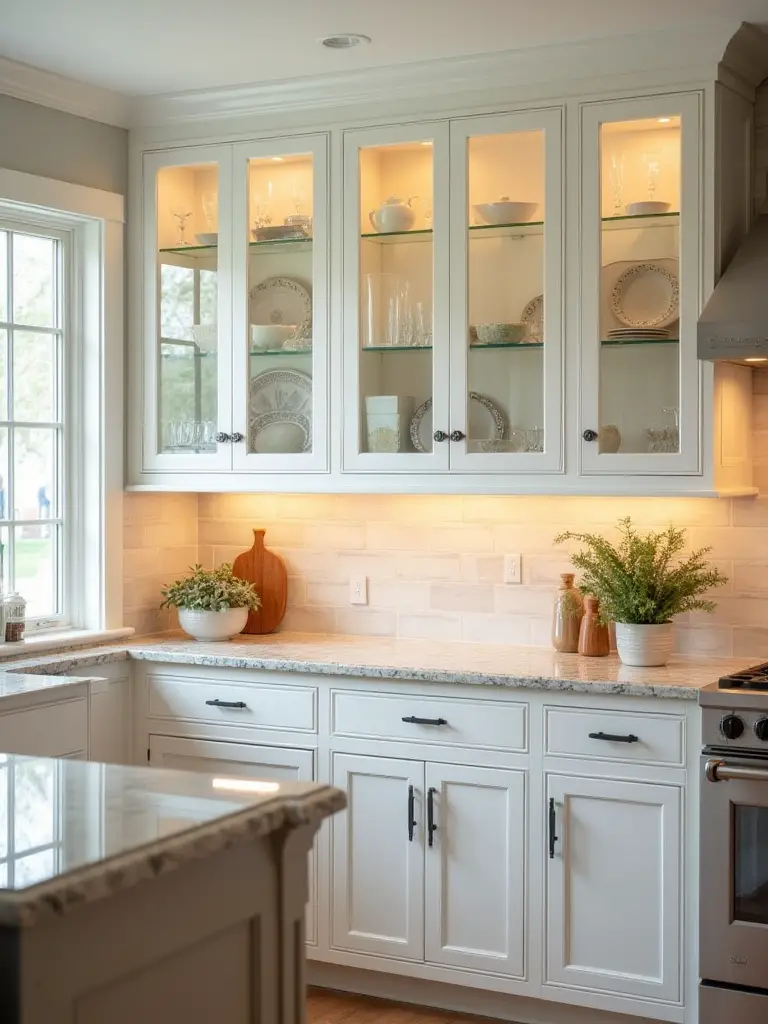
For an even more authentic traditional touch, consider using a type of antique or textured glass. Seeded glass has tiny bubbles trapped within it, while reeded glass has a beautiful linear texture. Leaded or mullioned glass fronts add a classic architectural pattern. These options provide a lovely, slightly distorted view that obscures the contents just enough so you don’t have to keep everything perfectly tidy, while still bouncing light around the room.
16. Add Custom Built-Ins and Nooks for Enhanced Utility and Style
Nothing says “custom” like a built-in feature. These elements make a kitchen feel like it was truly designed for the home and the people who live in it. A banquette built into a sunny window corner creates a cozy Breakfast Nook that’s far more inviting than a simple table and chairs. Plus, you can often incorporate hidden storage drawers into the base of the bench seating.
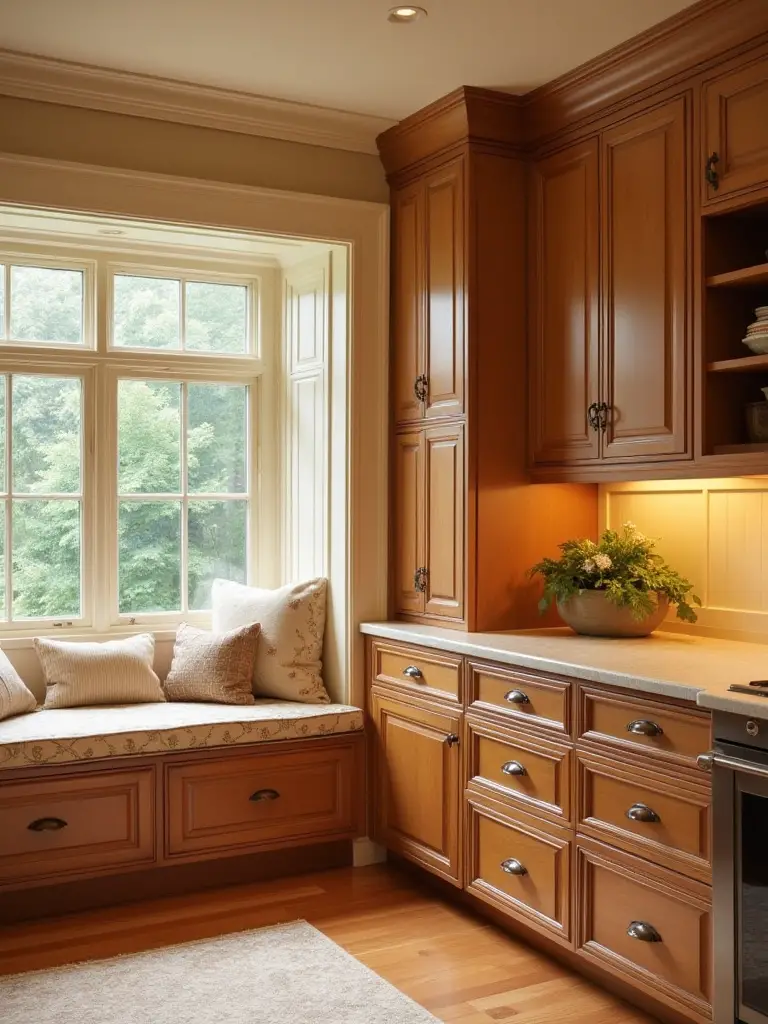
Other great examples include a floor-to-ceiling pantry unit that seamlessly matches the surrounding cabinetry or a small, built-in desk area for paying bills or looking up recipes. These thoughtful additions maximize every square inch of space and add a level of personality and function that freestanding furniture simply can’t match. They are what transform a collection of cabinets into a cohesive, thoughtfully designed room.
Adding Decorative Details and Functional Enhancements (Part 2)
Finally, let’s talk about the soft goods and personal touches. This is where you move beyond construction and into curation. These are the final layers that tell your personal story and make the kitchen feel warm, lived-in, and full of history.
17. Curate Classic Textiles and Window Treatments for Softness
A kitchen is full of hard surfaces—stone, wood, tile, metal. Without some softness to balance it all out, it can feel cold and sterile, and the acoustics can be terrible. Textiles are the answer. A simple Roman shade in a classic linen or a subtle patterned cotton adds texture, softness, and an opportunity for color. Café curtains hung on the bottom half of a window provide privacy while still letting in plenty of light.
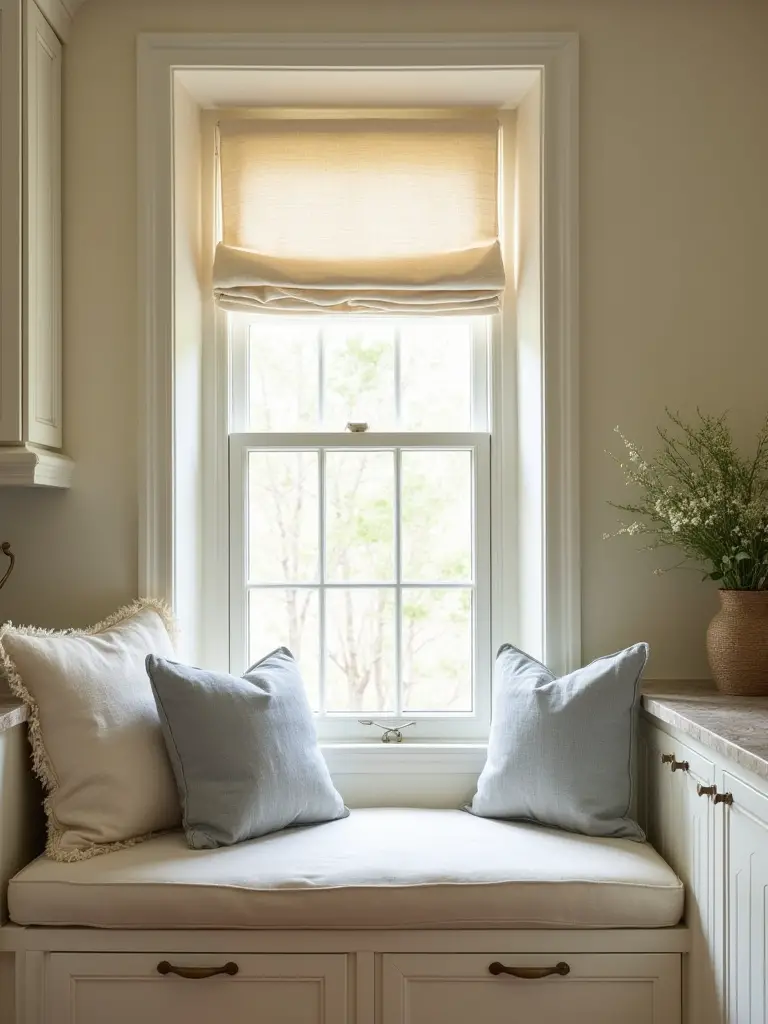
Don’t forget the floor. A durable vintage runner can add a beautiful splash of color and pattern, define a walkway, and make standing at the sink or stove for long periods much more comfortable. These soft touches are crucial for creating a room that feels inviting and finished. They absorb sound and light, making the entire space feel calmer and more comfortable.
18. Personalize with Antique or Vintage Accessories for Warmth and History
This might be the most important tip of all. A kitchen filled with nothing but brand-new items will always lack soul. You need to layer in objects with history. Hunt for a vintage oil painting at a flea market to hang on a small wall. Find an old marble slab to use as a pastry board or a collection of antique stoneware crocks to hold your utensils. An old wooden cutting board, worn smooth from decades of use, adds more character than any brand-new accessory.
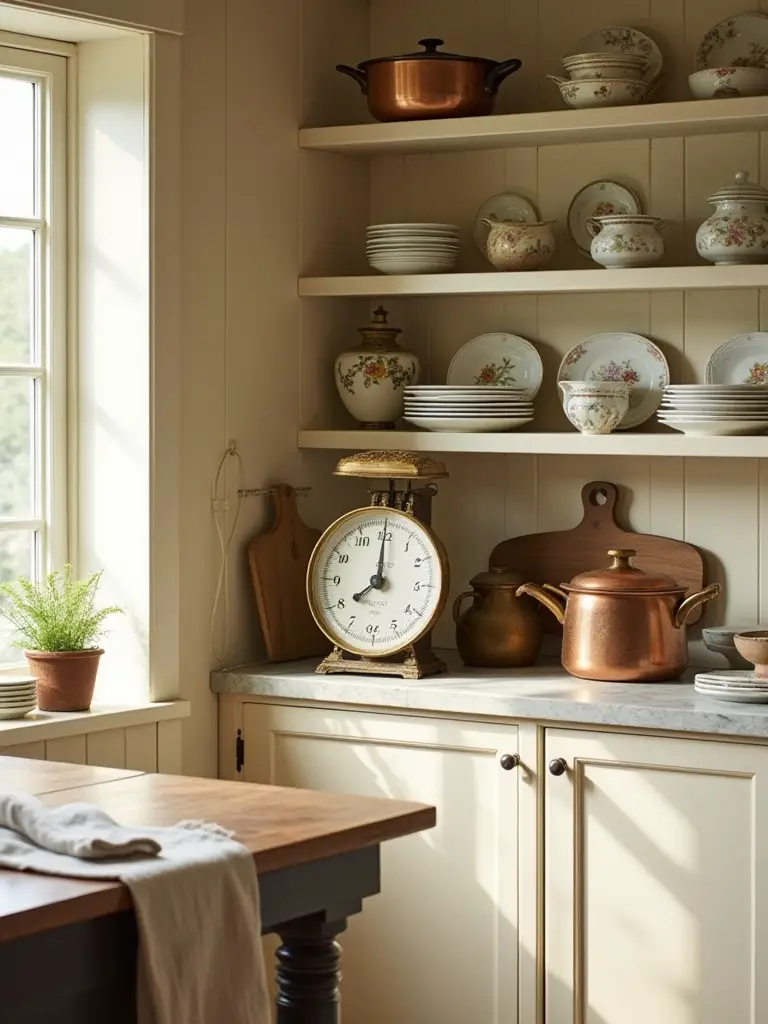
You don’t need to turn your kitchen into an antique shop. Just a few carefully chosen pieces are enough to add that essential layer of warmth and history. These are the items that tell a story and keep your kitchen from feeling like a generic showroom. They reflect your personality and make the space uniquely, authentically yours.
Conclusion
There you have it. Building a traditional kitchen isn’t about following trends; it’s about adhering to a set of principles that have proven to be timeless. It’s an investment in quality materials, thoughtful composition, and authentic details. By focusing on a functional layout, embracing classic colors and cabinet styles, and layering in textures and personal history, you can create a kitchen that feels both new and as if it has always been there.
The real beauty of traditional design is its staying power. When you get the foundation right and fill the space with quality pieces and personal touches, you’re not just building a room for today—you’re creating the heart of your home for decades to come. Now you have the blueprint. Go create a space that’s not just beautiful for a photograph, but is deeply, enduringly functional and full of soul for your real life.
